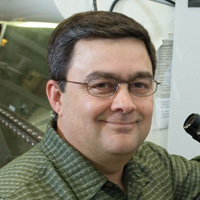Center for PFAS Research Faculty Spotlight: Brad L. Upham
Dr. Brad Upham’s contribution of determining the potential adverse health effects of PFAS is an important mission of the MSU Center for PFAS Research.
 Dr. Brad L. Upham is an Associate Professor in the College of Human Medicine’s Department of Pediatrics and Human Development. Dr. Upham conducts innovative research in cell biology determining the underlying signaling mechanisms involved in epigenetic responses of mammalian cells to environmental contaminants, oxidative stress, and oncogenes; and how chemopreventive agents from natural products interact with these signaling pathways in preventing or reversing the tumor promoting effects of environmental toxicants and oncogenes. Various microscopy, proteomic, lipidomic and transcriptomic approaches are used to map out novel signaling pathways that control gene expression using in vitro stem cell systems.
Dr. Brad L. Upham is an Associate Professor in the College of Human Medicine’s Department of Pediatrics and Human Development. Dr. Upham conducts innovative research in cell biology determining the underlying signaling mechanisms involved in epigenetic responses of mammalian cells to environmental contaminants, oxidative stress, and oncogenes; and how chemopreventive agents from natural products interact with these signaling pathways in preventing or reversing the tumor promoting effects of environmental toxicants and oncogenes. Various microscopy, proteomic, lipidomic and transcriptomic approaches are used to map out novel signaling pathways that control gene expression using in vitro stem cell systems.
Among the many environmental contaminants studied, per- and polyfluoroalkyl substances (PFAS) is a significant focus of his research program. Several seminal papers were published establishing structure-activity relationships of PFAS that dysregulate gap junctional intercellular communication (GJIC) through specific signal transduction pathways using both in vitro and in vivo approaches. One underlying hypothesis of our research is that GJIC is essential in maintaining tissue homeostasis and the dysregulation of GJIC is one of several essential steps in the early stages of tumorigenesis and other growth and development diseases. Thus, we use GJIC-based bioassays as a first step in the assessment of the tumorigenic potential of environmental contaminants, including PFAS. For example, perflourinated fatty acids with chain lengths between seven and ten carbons dysregulate GJIC, while carbon chain lengths less than six or greater than ten do not, and the activation of mitogen activated protein kinases and specific phospholipases are part of this process. GJIC is also used as a biological anchor for advanced proteomic and lipidomic analyses, which has been instrumental in our determining oncogenic-relevant intracellular signaling pathways activated in response to environmental contaminants. Various natural products, such as curcumin, quercetin and silibinin, were shown to prevent PFAS-induced dysregulation of GJIC. Presently, we have an R21 NIH award to develop a novel high throughput system (HTS) to assess GJIC , which will be used to screen the numerous PFAS found in our environment for effects on GJIC as well as for natural products that could potentially prevent or reverse PFAS-induced dysregulation of GJIC.
Dr. Brad Upham’s contribution of determining the potential adverse health effects of PFAS is an important mission of the center. The use of gap junction-based bioassays to begin the assessment of toxicity is of great value for the center in establishing novel data bases that can be used along with other toxicity-based PFAS libraries in determining adverse health risks of both the parent compounds as well as intermediate byproducts generated from remediation efforts. Also, the use of GJIC to screen for potential natural products that can prevent or reverse the toxic effects of PFAS offers potential nutrition-based preventive strategies, as removal of these compounds from these “forever chemicals” will probably take many generations. Thus, ameliorating the toxic effects of PFAS can potentially reduce adverse health outcomes to the highly exposed populations, which is quite relevant to the mission of this center.
Dr. Upham appreciates spending time with family, friends, and pets. Especially loves outdoor activities such as nature hikes, backpacking, camping, fishing, canoeing, kayaking, and snorkeling. His favorite hikes are in the mountains when he visits family in New England and out west. He is also an avid year-round ice hockey player.



 Print
Print Email
Email




